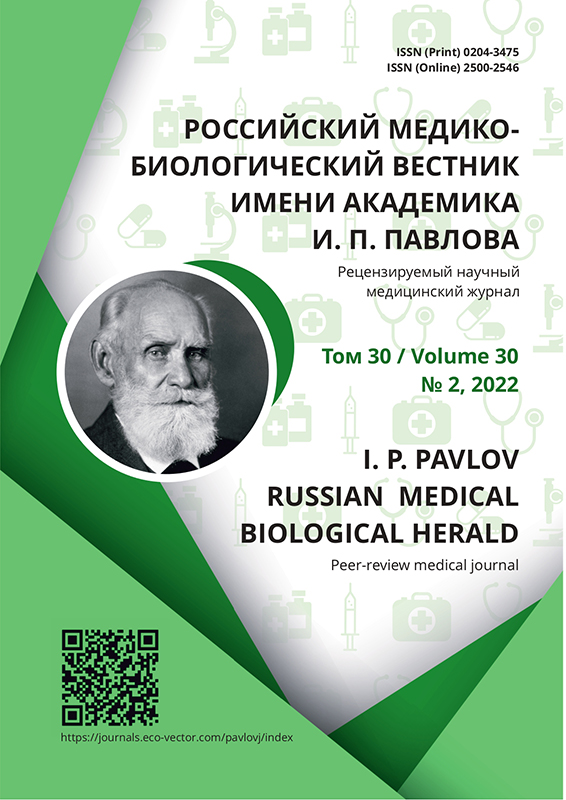Влияние износа водоразводящей сети на эпидемиологическую безопасность питьевой воды в малых городах Рязанской области
- Авторы: Соловьёв Д.А.1, Дементьев А.А.1, Ляпкало А.А.1, Литвинова А.А.1, Коршунова Е.П.1
-
Учреждения:
- Рязанский государственный медицинский университет имени академика И. П. Павлова
- Выпуск: Том 30, № 2 (2022)
- Страницы: 175-182
- Раздел: Оригинальные исследования
- Статья получена: 18.11.2021
- Статья одобрена: 23.03.2022
- Статья опубликована: 29.06.2022
- URL: https://journals.eco-vector.com/pavlovj/article/view/84092
- DOI: https://doi.org/10.17816/PAVLOVJ84092
- ID: 84092
Цитировать
Аннотация
Введение. Санитарно-эпидемиологическая надежность (СЭН) системы централизованного питьевого водоснабжения (СЦПВ) является одним из определяющих факторов качества питьевой воды, оценивается по специальной методике, разработанной Федеральным научным центром гигиены имени Ф. Ф. Эрисмана.
Цель. Комплексная гигиеническая оценка надежности СЦПВ малых городов Рязанской области (РО) и кишечных инфекций у подростков с позиций микробиологических показателей качества питьевой воды.
Материалы и методы. Исследование проводилось совместно с Центром гигиены и эпидемиологии в РО в шести районных центрах РО, которые водоснабжаются из различных водоносных горизонтов. Пробы воды отбирались по стандартной методике МУК 4.2.1018-01. В отобранных пробах воды определялись микробиологические показатели качества питьевой воды, оценка которых проводилась в соответствии с СанПиН 1.2.3685-21. Статистический анализ результатов был выполнен в пакете прикладных лицензионных программ Microsoft Excel 2019, IBM SPSS Statistics 19.
Результаты. Зарегистрированный уровень обобщенного комплексного показателя СЭН СЦПВ составил: для г. Скопина — 1,6 балла (наиболее неблагоприятная ситуация), г. Михайлова — 1,3 балла, г. Ряжска — 1,1 балла, г. Касимова — 0,4 балла, г. Кораблино и г. Сасово — по 0,3 балла (наименее неблагоприятная ситуация). В г. Скопине, Ряжске и Михайлове зарегистрирована корреляция высокой силы между повышенным содержанием микробиологических показателей и заболеваемостью дизентерией и острыми кишечными инфекциями вирусной этиологии у подросткового населения.
Заключение. Наиболее низкий уровень СЭН СЦПВ зарегистрирован в г. Скопине, Михайлове и Ряжске. Продемонстрирована прямая корреляционная связь высокой силы между превышением допустимых значений микробиологических показателей в питьевой воде этих городов РО и уровнем заболеваемости подростков дизентерией и кишечными инфекциями вирусной этиологии.
Полный текст
Об авторах
Давид Андреевич Соловьёв
Рязанский государственный медицинский университет имени академика И. П. Павлова
Автор, ответственный за переписку.
Email: soldos1@yandex.ru
ORCID iD: 0000-0002-9599-8285
SPIN-код: 9783-2217
Россия, Рязань
Алексей Александрович Дементьев
Рязанский государственный медицинский университет имени академика И. П. Павлова
Email: a_dementiev@mail.ru
ORCID iD: 0000-0003-3038-5530
SPIN-код: 3797-9108
д.м.н., доцент
Россия, РязаньАлександр Андреевич Ляпкало
Рязанский государственный медицинский университет имени академика И. П. Павлова
Email: lyapkalo_a@mail.ru
ORCID iD: 0000-0002-3956-5514
SPIN-код: 3014-9250
д.м.н., профессор
Россия, РязаньАнастасия Александровна Литвинова
Рязанский государственный медицинский университет имени академика И. П. Павлова
Email: anastasiya_smoro@mail.ru
ORCID iD: 0000-0002-1877-2661
SPIN-код: 6920-8401
Россия, Рязань
Елена Петровна Коршунова
Рязанский государственный медицинский университет имени академика И. П. Павлова
Email: gigikorsh@yandex.ru
ORCID iD: 0000-0002-9042-3888
SPIN-код: 5445-8991
к.м.н.
Россия, РязаньСписок литературы
- Даудова М.Г., Багомедова Р.Б., Бекшоков К.К., и др. Влияние качества источников питьевого водоснабжения на формирование эколого-зависимой патологии населения республики Дагестан // Юг России: экология, развитие. 2020. Т. 15, № 4. С. 168–176. doi: 10.18470/1992-1098-2020-4-168-176
- Кику П.Ф., Кислицына Л.В., Богданова В.Д., и др. Гигиеническая оценка качества питьевой воды и риски для здоровья населения Приморского края // Гигиена и санитария. 2019. Т. 98, № 1. С. 94–101. doi: 10.18821/0016-9900-2019-98-1-94-101
- Ковальчук В.К., Ямилова О.Ю. Качество питьевой воды и умственная работоспособность подростков на юге Дальнего Востока России // Экология человека. 2020. № 7. С. 32–39. doi: 10.33396/1728-0869-2020-7-32-39
- Байдакова Е.В., Унгуряну Т.Н., Крутская К.В., и др. Качество питьевого водоснабжения и степень эпидемической опасности возникновения кишечных инфекций в городах Архангельской области // Экология человека. 2019. № 5. С. 15–20. doi: 10.33396/1728-0869-2019-5-15-20
- Корчин В.И., Корчина Т.Я., Терникова Е.М., и др. Влияние климатогеографичеких факторов Ямало-Ненецкого автономного округа на здоровье населения // Журнал медико-биологических исследований. 2021. Т. 9, № 1. С. 77–88. doi: 10.37482/2687-1491-Z046
- Трофимович Е.М., Айзман Р.И. Система метаболизма питьевой воды как методическая основа оценки её минерального состава // Гигиена и санитария. 2019. Т. 98, № 5. С. 555–562. doi: 10.47470/0016-9900-2019-98-5-555-562
- Механтьев И.И., Клепиков О.В. Комплексная оценка санитарно-эпидемиологической надежности систем централизованного питьевого водоснабжения сельских территорий // Вестник новых медицинских технологий. Электронное издание. 2020. № 5. С. 119–124. Доступно по: http://www.medtsu.tula.ru/VNMT/Bulletin/E2020-5/2-1.pdf. Ссылка активна на 18.11.2021. doi: 10.24411/2075-4094-2020-16754
- Сёмка И.М., Казаева О.В. Анализ качества питьевой воды в Рязанской области // Наука молодых (Eruditio Juvenium). 2013. № 3. С. 71–74.
- Соловьёв Д.А., Дементьев А.А., Ляпкало А.А., и др. Анализ качества питьевой воды водоразводящей сети в некоторых муниципальных образованиях Рязанской области // Вестник новых медицинских технологий. Электронное издание. 2019. № 3. С. 92–97. Доступно по: http://www.medtsu.tula.ru/VNMT/Bulletin/E2019-3/2-2.pdf. Ссылка активна на 18.11.2021. doi: 10.24411/2075-4094-2019-16371
- Литвинова А.А., Дементьев А.А., Ляпкало А.А., и др. Сравнительная гигиеническая характеристика качества поверхностных вод в местах водозаборов областного центра // Наука молодых (Eruditio Juvenium). 2019. Т. 7, № 3. С. 366–372. doi: 10.23888/HMJ201973366-372
- Плетенева Т.В., ред. Токсикологическая химия. М.: ГЭОТАР-Медиа; 2005.
- СанПиН 2.1.3684-21. Санитарно-эпидемиологические требования к содержанию территорий городских и сельских поселений, к водным объектам, питьевой воде и питьевому водоснабжению, атмосферному воздуху, почвам, жилым помещениям, эксплуатации производственных, общественных помещений, организации и проведению санитарно-противоэпидемических (профилактических) мероприятий. М.; 2021.
- Алешня В.В., Журавлев П.В., Седова Д.А., и др. Балльная оценка потенциального риска возникновения ОКИ, передаваемых водным путем. В кн.: Современные методологические проблемы изучения, оценки и регламентирования факторов окружающей среды, влияющих на здоровье человека: материалы Международного форума Научного совета Российской Федерации по экологии человека и гигиене окружающей среды, посвященного 85-летию ФГБУ «НИИ ЭЧ и ГОС им. А.Н. Сысина» Минздрава России: в 2 ч. М.; 2016. Т. 1. С. 41–44.
- Андреева Е.Е., Иваненко А.В., Силиверстов В.А., и др. Актуальные проблемы организации контроля за качеством воды водоисточников и питьевой воды в городе Москве // Профилактическая и клиническая медицина. 2015. № 2 (55). С. 5–11.
- Опарин А.Е. Гигиеническая оценка условий централизованного водоснабжения с позиции риска здоровью // Сибирский медицинский журнал (Иркутск). 2012. № 5. С. 99–102.
- МУК 4.2.1018-01. Санитарно-микробиологический анализ питьевой воды. М.: Федеральный центр гигиены и эпидемиологии Роспотребнадзора; 2001.
- СанПиН 1.2.3685-21. Гигиенические нормативы и требования к обеспечению безопасности и (или) безвредности для человека факторов среды обитания. М.: Минздрав России; 2003. С. 47–105.
- МР 2.1.4.2370-08. Оценка санитарно-эпидемиологической надежности систем централизованного питьевого водоснабжения. М.: Федеральный центр гигиены и эпидемиологии Роспотребнадзора; 2009.
Дополнительные файлы










